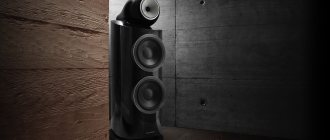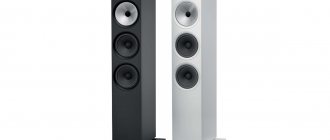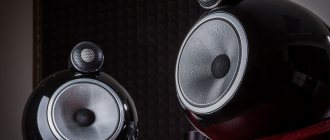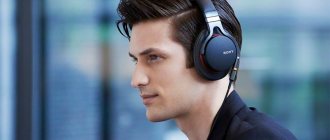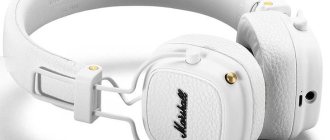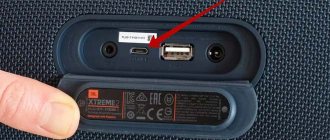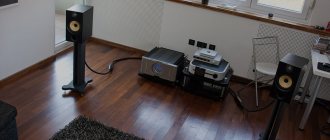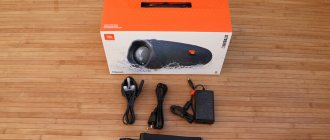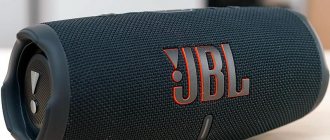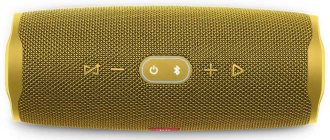With the Bowers & Wilkins P3, I've found the perfect on-ear headphones for travel. Compact, robust, foldable, excellent design and made of quality materials. They sound at the same level, or even better, than most “adult” headphones in the same price range that I have heard. Although sound is very individual, because everyone has their own ears, and so do their musical preferences. But in addition to the P3, there are a couple of larger headphones in the Bowers & Wilkins lineup. Naturally, after a positive experience with a portable model, I wanted to try others too, and I was able to work with the flagship of the series - Bowers & Wilkins P7 . Impression? They are difficult to put into words, but I will try to do so in this review.
Rich
The P7 is Bowers & Wilkins's first full-size headphones , and the company has tried to put the maximum into them: the best case materials, the best electronic components and original packaging. The box greets the user with high-quality, very tough and thick cardboard, chic printing and the absence of unnecessary tinsel, such as packaging cellophane on headphones. Moreover, it is made in the form of a kind of exhibition stand with beveled edges. I placed this in a visible place and can be used as a storage place for P7:
Under a fairly rigid and fabric-covered stand there is a leather-like case, an additional audio cable, a 3.5→6.3 mm adapter and a set of papers identical to the P3 in a plastic envelope (instructions, a brief history of the company with illustrations, a warranty card).
An interesting point is that the headphones are quite large in size, but due to the well-thought-out folding design and included case, they will take up significantly less space in your bag than similar full-size models from competitors.
To get an idea of the dimensions of the Bowers & Wilkins P7 folded and in the case, I suggest you look at the photos below. So, in height they are no larger than a paperback book:
But this is what happens if you hide the P7 in a case and compare it with the iPhone 5s in the BookBook cover:
As you can see, the company has come up with a really compact solution (weight - 290 g), which, in principle, can be taken on the road by people accustomed to uncompromising sound, but we will talk about the acoustic capabilities of the accessory a little later.
For now, let's focus on the headphones themselves, fortunately, there is something to look at.
The design uses aluminum, steel and high-quality genuine leather. The ear cups on the outside are made of light silver metal, plus they are trimmed in leather, as are the soft ear pads.
The accessory evokes associations with a luxury sedan with a leather interior and chrome elements.
The massive headband is also trimmed with leather, on which the white stitching stands out brightly:
The picture is completed by a mirror-polished steel frame that holds the earcups and a hinge made of the same material.
The hinge has a spring mechanism that holds the headphones closed or open. It works softly but clearly, the assembly is monolithic.
The height of the headphone arms is adjusted in the same way as in the P3. That is, there is no discrete ratchet, instead there is a dynamic design that ensures smooth operation if you apply some effort. The design of the P7 is very similar to the P3, or vice versa. It is difficult to say which of them was invented first.
Continuing to compare the devices, you can find another similarity - removable ear pads, under which a 2.5 mm cable connector is hidden. It connects to only one earphone, but the ear pads can be removed from both.
They are held securely in place by magnets and a pair of metal pins.
If you don’t know about the collapsible design, it’s difficult to discover it yourself. All details fit together perfectly:
In addition to the headphones, metal is present in the 3.5 mm jack and in the remote control with microphone built into the wire.
The buttons are comfortable, have a clear click and are easy to find by touch. The included microphone works well, but it doesn’t stand out as anything special among its analogues. The remote control is designed for Apple technology, plus it is partially functional when used with modern Android smartphones (the play/pause button works). Or you can connect a second, universal cable that is compatible with any devices with a built-in mini-jack.
In general, the general impressions of the headphones are as follows: they look rich, they are assembled monolithically, and the tactile sensations are that you don’t want to let them go out of your hands or take them off your head. Well, let's discuss the operating experience and sound.
Noise reduction system
There is an active noise reduction; microphones in each earcup are capable of picking up ambient sounds and delivering them in antiphase. Alas, the system’s operation is almost unnoticeable: I tried it in the office and even on an airplane, the hum of the turbines seeps through, you can even calmly answer the flight attendant without turning off the movie. In addition, when you turn on ANC from the button, there is no voice notification about the action - it’s not clear whether the noise reduction is on or not?
So if you are planning to buy PI7 for active noise cancellation, I advise you to immediately forget about it. The transparency mode is well done, but there are some issues with ANC. I repeat every time, with the AirPods Pro you turn on the noise cancelling, and the way you apply pillows to your ears, there is no trace of that here.
Music
The PI7 has two drivers in each cup, an “armature” for high/mid frequencies and a dynamic one for low frequencies. The combination has been known for a long time, has been tested and has proven itself well. There is one downside: wireless headphones have a reduced operating time, which is what we see with the PI7.
But, believe me, I won’t complain about it, because the headphones sound great with a wide variety of services and a wide variety of music. Almost all the time I used headphones from my iPhone, listened to Apple Music, Spotify and my now favorite app, Endel, a service where a neural network creates music for concentration, relaxation or other tasks. I highly recommend trying it!
Well, anticipating possible questions about Lossless in Apple Music - naturally, PI7 will also not support “heavy” music, like all AirPods. This surprises many, but, friends, it all depends on the Bluetooth connection and nothing can be done. If you want to listen to Lossless on your iPhone, look for high-quality wired headphones, maybe even a portable DAC.
If you approach the PI7 with any Android-based smartphone, the listening result can be even better than when paired with an iPhone: the headphones support the Qualcomm aptX Adaptive codec and 24-bit audio transmission. But, to be honest, all this is very conditional - as practice shows, there will be no dramatic difference in sound quality. Or rather, it all really depends on what kind of smartphone you have, what codecs it supports, and on what platform.
I tried listening to the PI7 paired with the Samsung Galaxy Z Fold 2, the same services, Spotify and others. It’s very strange, maybe it just seemed to me, but there’s somehow more sound, it’s richer, there’s more detail, the difference was especially noticeable when paired with Spotify. Yes, this is not an Audeze LCD-2 with a HiFi player, but a very, very, very interesting combination! This is the case when you just want to listen to many tracks again. Please note that the Bowers & Wilkins program displays the codec used: with the iPhone it is AAC, with the Fold 2, respectively, aptX.
It’s impossible not to compare PI7 and AirPods Pro, even if the former are more expensive, the products are similar in functionality. I used an iPhone for comparison. It seemed to me that AirPods Pro play more smoothly, more clearly for me and for most users. While the PI7s show great pictures in one track, they don't show anything special in another. But once you connect to the Fold 2, I would definitely stay with the PI7, in most cases they sound more interesting.
Application
I tried the iOS version. You need to install it for the sake of being able to update the headphone software, turn off the sensors in the cups if you are tired, and then the transparency mode is turned on. The level of transparency mode is adjustable. You can turn it on without the application by pressing and holding the button on the left cup. The transparency mode is good: without removing the headphones, you can perfectly hear your colleagues in the next room and communicate with them. The voice is heard.
The application displays the charge level, the color of the headphones matches your model - PX5 and small PI3/PI4 will live in the same program, their reviews will be published soon.
Functions and Features
Bowers & Wilkins always tries to incorporate the best cutting-edge technology into their headphones, and the PX7 has some nice changes. Wear sensors have appeared again, and in a modified form. Take off the headset and the song will stop. Put it back on, and magically the music will immediately start playing. If the headphones are removed, they will go into standby mode after a while; but as soon as you put them on, they start working again. This is a convenient feature that after a few weeks you can no longer do without.
Battery life has increased from 22 to 30 hours. Of course, this figure is based on “average” values of all working functions, but you definitely won’t have to charge the PX7 too often. 15 minutes. recharging will allow them to work for about five hours.
The noise reduction function has also changed. Flight/City/Office modes have changed to Low/Automatic/High noise reduction. Low is appropriate for the city and allows you to hear the surrounding noise, which guarantees greater safety. Automatically adapts to external conditions. High is suitable for the most crowded places or for any loud environment. A new mode has also appeared in the B&W PX7 - Custom, which allows you to control the level of transmitted noise. You can enable it via the slider in the Headphones application.
If you pull the slider down, the sound is completely isolated; up - all the noise will be heard. In the middle, accordingly, there will be an average value between the two. This setup method is very convenient, especially if you are talking on the phone at the same time, and removing the headphones is inconvenient. Update notifications will also be sent through the application.
In airplane
I tried the headphones on the plane, and the flight was immediately hellish: we flew to Amsterdam at night, there was an hour and a half transfer to Portugal. The return trip is even more fun: in the morning from Portugal to Amsterdam, a few hours transfer to Moscow. Here it was possible to check both noise reduction and operating time - about thirty hours were stated.
I'll start with noise reduction. I will not stop asserting that the Bose NCH 700 has the best noise reduction. You immediately find yourself in silence. But many people don’t like some kind of unnecessary pressure: I personally don’t notice it - opacity and God knows what else. In general, this is a good lesson for those who consider their opinion and their choice to be exclusive: if Bose suited everyone, I would not see such diversity on the plane. And thousands of Sony, and Senhi, and Bowers & Wilkins PX, and AirPods, both regular and Pro.
Bowers & Wilkins PX7 does not have such crushing noise reduction: you are not separated from the world by a protective wall, you better perceive what is happening around you. But even the strong noise is masked. It was a pleasure to fly. There are no questions about convenience, no discomfort. In terms of operating time too - judging by the behavior of the headphones, you can safely fly even to Australia and not think about charging.
The downside is the same as other headphones. You can’t rest your head against the wall, the cups are in the way. I advise you not to forget your airplane pillow at home—it’s more comfortable to sleep with. Well, don’t forget to put on some program with various sounds of nature, this is a real lifesaver. When we flew at night from Moscow to Amsterdam, I turned on the sound of rain and slept without hind legs, great. You can use the Relax Meditation program, if you know something better, write.
It’s nice when the headphones have USB Type-C: I charged the iPad Pro during the flight and immediately connected the cable to the headphones for a short time. I also really enjoyed watching movies with the Bowers & Wilkins PX7 - the sound is top-notch. Dialogues, all sorts of effects, shots, explosions - everything is absolutely excellent. I decided to review “The Pacific Ocean” and was right, it was very good. I also watched The Mandalorian, the atmosphere was perfectly conveyed. Of course, when there are huge drivers, and they are configured well, what else can you expect.
One last note about the flight: I said that there were no problems with convenience. But the Bowers & Wilkins PX7 are somewhat oakier than the Bose NCH 700, they do not fit as tightly - but there is more room for the ears. You can buy without trying on, but if you really fly often, then it’s better to try both models.
Overall, I'm really pleased. Bowers & Wilkins took into account the shortcomings of the previous model and made a serious English killer for any other noise-canceling model. And there are also top-end sensors: you move the cup back - the movie pauses, you calmly chat with the flight attendant, get your tomato juice - continue watching. Topovo! And what’s also great is that the buttons are mechanical: you won’t accidentally press them, no matter how you press your cup against the wall, the back of the seat, or the shoulder of your charming neighbor.
Bowers & Wilkins PX7 Specifications
- Sound output mode: stereo.
- Active Noise Cancellation: Yes.
- Frequency range: 10 – 30,000 Hz.
- Sensitivity: 111 dB.
- Impedance: 20,000 Ohms.
- Bluetooth version: 5.0.
- Kodaks and audio protocols: aptX, aptX HD, aptX Adaptive audio, AAC, SBC.
- Source connector type: 3.5 mm.
- Additional accessories: USB-C charging cable, case.
- Battery life: 30 hours.
- Bluetooth range: 10 m.
- Price: 25 thousand rubles. ($385).
No wires - there is sound
As I wrote above, the PX7 Carbon Edition supports aptX Adaptive Bluetooth technology, which is designed specifically for transmitting high-resolution 24-bit/48 kHz music over the air. So you will hear the music in maximum resolution, but maintaining a neutral panorama and tonal balance.
In general, listening to my music library, I experienced the same sensations as listening to music on a Hi-Fi audio system. Serious, clear bass literally vibrates and you feel it on a physical level.
The bass is so good that it literally creates a physical sensation. Mids and highs are soft yet detailed. Overall, the sound of the PX7 Carbon Edition can be described as “ airy ”. You can feel the volume and integrity of the entire frequency spectrum, and in some compositions I heard some nuances for the first time thanks to the sound of the PX7.
For example, the song Blink 182 – All the Small Things, which you all undoubtedly know, has a catchy hook in the chorus. It’s hard to hear, but when listening to this track with PX7 Carbon Edition headphones, you can clearly hear the octave synthesizer in the chorus.
And over the entire period of using the PX7 Carbon Edition, I have accumulated a fair number of such examples. You can really hear something new even in those songs that you seem to know by heart.
So I'm really impressed with the sound of these headphones. And I began to listen to a lot more music, loving to find and notice what I had not heard in other headphones.
